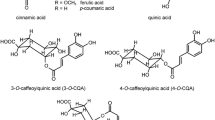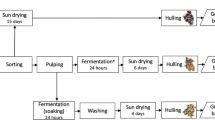Abstract
This study was performed to compare the effects of brewing method (decoction and infusion), time (1–5 min), and also origin of coffee beans on antioxidant activity using DPPH, ABTS, FRAP methods, caffeine content and phenolic compounds by HPLC. Principal component analysis was used to determine the effective treatments on bioactive properties. Coffee brews prepared with decoction method contained higher contents of total phenolic, total flavonoid, and total tannin as compared to the infusion method. On the other hand, antioxidant activity of coffee brews by DPPH and ABTS radical methods showed an opposite trend. Similar to antioxidant activity, infusion method was better to obtain higher amounts of catechin, caffeic acid and quercetin in coffee brews. The brewing method did not cause a significant difference in caffeine and rutin contents. Brewing time had major effects on several bioactive compounds, and their amounts showed an increase after extending the time of brewing.

Similar content being viewed by others
References
Kaur M, Tyagi S, Kundu N (2018) Effect of brewing methods and time on secondary metabolites, total flavonoid and phenolic content of green and roasted coffee Coffea arabica, Coffea canephora and monsooned malabar. Eur J Med Plants 23(1):1–16
das Neves JVG, Borges MV, de Melo Silva D, dos Santos Leite CX, Santos MRC, de Lima NGB, da Silva Lannes SC, da Silva MV (2019) Total phenolic content and primary antioxidant capacity of aqueous extracts of coffee husk: chemical evaluation and beverage development. Food Sci Technol 39:348–353
Olechno E, Puścion-Jakubik A, Zujko ME, Socha K (2021) Influence of various factors on caffeine content in coffee brews. Foods 10(6):1208
Olechno E, Puścion-Jakubik A, Markiewicz-Żukowska R, Socha K (2020) Impact of brewing methods on total phenolic content (TPC) in various types of coffee. Molecules 25(22):5274
Çelik EE, Gökmen V (2018) A study on interactions between the insoluble fractions of different coffee infusions and major cocoa free antioxidants and different coffee infusions and dark chocolate. Food Chem 255:8–14
Górecki M, Hallmann E (2020) The antioxidant content of coffee and its in vitro activity as an effect of its production method and roasting and brewing time. Antioxidants 9(4):308
Bilge G (2020) Investigating the effects of geographical origin, roasting degree, particle size and brewing method on the physicochemical and spectral properties of Arabica coffee by PCA analysis. J Food Sci Technol 57(9):3345–3354
Cordoba N, Pataquiva L, Osorio C, Moreno FLM, Ruiz RY (2019) Effect of grinding, extraction time and type of coffee on the physicochemical and flavour characteristics of cold brew coffee. Sci Rep 9(1):1–12
Gloess AN, Schönbächler B, Klopprogge B, Lucio D, Chatelain K, Bongartz A, Strittmatter A, Rast M, Yeretzian C (2013) Comparison of nine common coffee extraction methods: instrumental and sensory analysis. Eur Food Res Technol 236(4):607–627
Wang X, William J, Fu Y, Lim L-T (2016) Effects of capsule parameters on coffee extraction in single-serve brewer. Food Res Int 89:797–805
Komes D, Bušić A (2014) Antioxidants in coffee. Processing and impact on antioxidants in beverages. Elsevier, Oxford, UK, pp 25–32
Petracco M (2001) Beverage preparation: brewing trends for the new millennium. In: Clarke RJOGV (ed) Coffee recent developments. Blackwell Science, London, p 140
Cordoba N, Fernandez-Alduenda M, Moreno FL, Ruiz Y (2020) Coffee extraction: a review of parameters and their influence on the physicochemical characteristics and flavour of coffee brews. Trends Food Sci Technol 96:45–60
Muñoz AE, Hernández SS, Tolosa AR, Burillo SP, Herrera MO (2020) Evaluation of differences in the antioxidant capacity and phenolic compounds of green and roasted coffee and their relationship with sensory properties. LWT Food Sci Technol 128:109457
Jeon J-S, Kim H-T, Jeong I-H, Hong S-R, Oh M-S, Park K-H, Shim J-H, Abd El-Aty A (2017) Determination of chlorogenic acids and caffeine in homemade brewed coffee prepared under various conditions. J Chromatogr B 1064:115–123
Yoo KM, Lee KW, Park JB, Lee HJ, Hwang IK (2004) Variation in major antioxidants and total antioxidant activity of Yuzu (Citrus junos Sieb ex Tanaka) during maturation and between cultivars. J Agric Food Chem 52(19):5907–5913
Hogan S, Zhang L, Li J, Zoecklein B, Zhou K (2009) Antioxidant properties and bioactive components of Norton (Vitis aestivalis) and Cabernet Franc (Vitis vinifera) wine grapes. LWT Food Sci Technol 42(7):1269–1274
Haile M, Kang WH (2019) Antioxidant activity, total polyphenol, flavonoid and tannin contents of fermented green coffee beans with selected yeasts. Fermentation 5(1):29
Salamanca CA, Fiol N, González C, Saez M, Villaescusa I (2017) Extraction of espresso coffee by using gradient of temperature. Effect on physicochemical and sensorial characteristics of espresso. Food Chem 214:622–630
Lee SK, Mbwambo Z, Chung H, Luyengi L, Gamez E, Mehta R, Kinghorn A, Pezzuto J (1998) Evaluation of the antioxidant potential of natural products. Comb Chem High Throughput Screen 1(1):35–46
Köseoğlu O, Sevim D, Kadiroğlu P (2016) Quality characteristics and antioxidant properties of Turkish monovarietal olive oils regarding stages of olive ripening. Food Chem 212:628–634
de Rezende Mudenuti NV, de Camargo AC, de Alencar SM, Danielski R, Shahidi F, Madeira TB, Hirooka EY, Spinosa WA, Grossmann MVE (2021) Phenolics and alkaloids of raw cocoa nibs and husk: the role of soluble and insoluble-bound antioxidants. Food Biosci 42:101085
Król K, Gantner M, Tatarak A, Hallmann E (2020) The content of polyphenols in coffee beans as roasting, origin and storage effect. Eur Food Res Technol 246(1):33–39
Patay ÉB, Sali N, Kőszegi T, Csepregi R, Balázs VL, Németh TS, Németh T, Papp N (2016) Antioxidant potential, tannin and polyphenol contents of seed and pericarp of three Coffea species. Asian Pac J Trop Med 9(4):366–371
Choi B, Koh E (2017) Spent coffee as a rich source of antioxidative compounds. Food Sci Biotechnol 26(4):921–927
Hečimović I, Belščak-Cvitanović A, Horžić D, Komes D (2011) Comparative study of polyphenols and caffeine in different coffee varieties affected by the degree of roasting. Food Chem 129(3):991–1000x
dePaulla J, Farah A (2019) Caffeine consumption through coffee: content in the beverage, metabolism health benefits and risks. Beverages 5:37
da Cruz RG, de Souza Vieira TMF, de Lira SP (2017) Potential antioxidant of Brazilian coffee from the region of Cerrado. Food Sci Technol 38:447–453
Muzykiewicz-Szymańska A, Nowak A, Wira D, Klimowicz A (2021) The effect of brewing process parameters on antioxidant activity and caffeine content in infusions of roasted and unroasted arabica coffee beans originated from different countries. Molecules 26(12):3681
Rao NZ, Fuller M, Grim MD (2020) Physiochemical characteristics of hot and cold brew coffee chemistry: the effects of roast level and brewing temperature on compound extraction. Foods 9(7):902
Ayseli MT, Kelebek H, Selli S (2021) Elucidation of aroma-active compounds and chlorogenic acids of Turkish coffee brewed from medium and dark roasted Coffea arabica beans. Food Chem 338:127821
Vignoli J, Bassoli D, Benassi MT (2011) Antioxidant activity, polyphenols, caffeine and melanoidins in soluble coffee: the influence of processing conditions and raw material. Food Chem 124(3):863–868
Author information
Authors and Affiliations
Corresponding author
Ethics declarations
Conflict of interest
Authors declare that they have no conflict of interest.
Compliance with ethics requirements
Ethics approval was not required for this research.
Additional information
Publisher's Note
Springer Nature remains neutral with regard to jurisdictional claims in published maps and institutional affiliations.
Rights and permissions
About this article
Cite this article
Uslu, N. The influence of decoction and infusion methods and times on antioxidant activity, caffeine content and phenolic compounds of coffee brews. Eur Food Res Technol 248, 2021–2030 (2022). https://doi.org/10.1007/s00217-022-04027-6
Received:
Revised:
Accepted:
Published:
Issue Date:
DOI: https://doi.org/10.1007/s00217-022-04027-6




